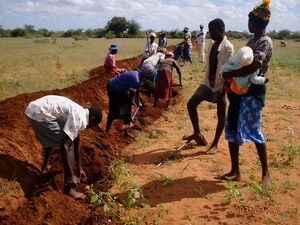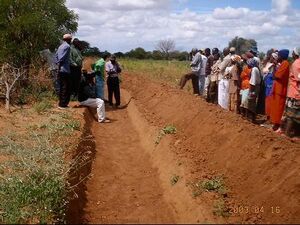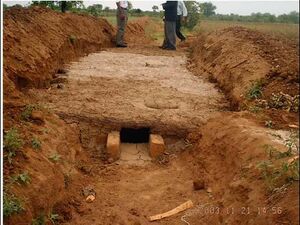The semi-arid regions experience long dry spells and erratic rainfall less than 500mm per annum. This is often poorly distributed over three months. In addition the areas experience high temperatures of about 38º Celsius resulting in high evaporation rates. Where soils are poor there is also deep percolation. Water received therefore quickly disappears within a few hours of a rainstorm. Farmers in Manama Communal Area in Gwanda district of Zimbabwe have modified the standard contour ridges and the infiltration pits to suit these conditions and named the technique - Manama Infield Rainwater Harvesting Storage Facility. This was after the realisation that farmers were losing water after harvesting it, resulting in total crop failures especially during the dry spells.
What is the Manama In-field Rainwater Harvesting Storage Facility?[edit | edit source]
This consists of a dead level contour with storage underground tanks made from local materials. The capacity range from 5m3 to 20m3 depending on farmer preference. A dead level contour is a channel dug in the field with a zero gradient or slopes, so that water does not flow but is harnessed and stored in the channel. The underground storage tanks are constructed in such a way that they are covered to reduce evaporation and rammed to reduce deep percolation.
Material requirements to make the facility[edit | edit source]
- An A-Frame to peg and grade the contour channel
- 1 rammer locally made from dry wood
- Ant-hill soil (termitaria), water
- 5 x 1,5-2m long dry poles
- pick
- shovel (depending on labour available)
- 10 farm/earth bricks
- Tape measure or ruler
- 2m string
- knife/hacksaw/small axe
- 50 wooden pegs
- old Hessian or plastic bags
How to construct the Manama in-field rainwater harvesting storage facility[edit | edit source]

Marking the contour[edit | edit source]
- Use the A-frame to mark contours.
- Choose a place on the slope to begin. Stand the A-frame up and mark where the first leg stands with a peg or large stone.
- Keeping the A-frame upright, and without moving the first leg, swing the second leg up or down the slope until the string crosses the cross bar exactly at the centre mark.
- Mark where the second leg stands with another peg.
- Keeping the second leg in the same place, lift the first leg up and pivot it on the ground. Move it up and down the slope until you find the place where the string crosses the crossbar at the centre mark.
- Continue in this manner to the end of the field.
- The line of pegs or stones will mark a contour line. They will be on the same height on the slope. The pegs are usually not in a straight line. If necessary make a smooth curve by moving them a little up or down.
- You can then dig channel and use the A-Frame to grade the channel to a zero gradient.
Farmers have observed that dead level contours harness rainwater but quickly lose that water due to evaporation and deep percolation. This brought the innovation of constructing the underground tanks described below. See picture below (Figure 2) of completed dead level contour. The minimum depth and width should be 30cm and 1500cm respectively. The length should be from end to end of the field.
Constructing the underground storage tank[edit | edit source]

- Along the dug channel choose where you can construct your storage tank. For soils that allow rapid percolation the storage tanks need to be closer together. For example most sand soils the tanks should be 10-15m apart while in clay soils it could be up to 25m.
- Measure along the channel 10metres and mark using pegs.
- Dig the marked area up to a further depth of 500cm or more. The deeper it is the more water will be harvested.
- Mark with a shovel the root zone depth within your tank.
- Place termitaria at the base of the tank and sprinkle water to facilitating easy ramming.
- Using homemade rammer, start ramming up to a maximum depth of 2-5cm. Sprinkle whenever required.
All the tanks in the last dead level contour may need a non-permeable layer therefore a thicker layer may be required. However all other tanks must be semi-permeable. Mix termitaria with water to make mortar and plaster up to the marked root zone level of your deep-rooted crops.
Covering the top of the underground tank[edit | edit source]

- Using earth bricks mark the inlet and outlets of your tank from both ends of your tank. (see picture below).
- Lay your wooden poles across your tank spaced at 2m.Ensure that the poles are not totally fixed for ease removal during maintenance usually during the dry season.
- Decide where you can place two openings at the top for collecting and checking water inside your tank.
- Lay old plastic or Hessian bags onto the poles.
- Use same mortar as referred above to plaster the roof of your tank.
See figure 3 for a completed water storage facility.
Advantages of this technique[edit | edit source]
- All materials used to make the facility are usually locally available and cheap
- The facility harness and store water up to five weeks making it available moisture to crops during the dry spell.
- Water is conserved, as there is reduced loss through evaporation and deep percolation.
- Reduced crop failures and results in increased crop yields.
- There is reduced soil loss and run off in the field.
- Increased crop diversity – food crops during the rainy season and vegetables during the dry season.
- The facility can also be used to make manure during the dry season.
Disadvantages of this technique[edit | edit source]
- This technique is labour intensive, which is impacted given the increased number of deaths from HIV/AIDS of people in the most active age groups; however, farmers have organised themselves to work in groups to share labour and skills in constructing the techniques.
- Farmers have found maintenance during the dry season tiresome.
Maintenance of the facility[edit | edit source]
To achieve maximum benefits from the facility, maintenance should be given utmost priority. During the dry season (usually soon after harvesting) when all water has been used from the tank remove the temporary top plaster.
- Remove the soil deposits and debris, which is usually very good nutrient source for your crops and spread it in your field.
- Repair and replaster any sides of your tank, which allow too much water to pass through.
- All crop residues for example maize stalks, grass that was growing in the dead level contours, rotten melons or pumpkins and material that can easily rot can be stacked into the open storage facility. This will be additional compost to improve on soil fertility at the start of the rainy season.
- After the first rains, remove all compost from the facility and plaster the top to ensure the facility is ready to harvest rainwater again.
- Working in groups is important in carrying out maintenance of the facility so the groups that dug the dead level should again work together.
Conclusion[edit | edit source]
The Manama In-field Rainwater Harvesting Storage Facility has enabled farmers in semi-arid areas to plan for and cope with disasters such as drought and diversify strategies for sustainable livelihoods. Formerly 'waste lands' have become productive fields giving farmers a worthwhile investment of their time in dryland farming.
Contact[edit | edit source]
Douglas Gumbo Technology Manager Practical Action Southern Africa P.O. Box 1744 Harare Zimbabwe practicalaction-zimbabwe@practicalaction.org.zw
References and further reading[edit | edit source]
- A-frame Practical Action Technical Briefs
- Underground rainwater storage facilities
- Simple Methods of Preventing Soil Erosion and Conserving Water: On a Technical Note by Nigel Walsh Baobab issue No 1 1988